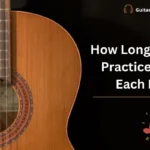For those who have played the guitar for a while now, experimenting with various tunings is a great way of discovering new sounds and tones. Among the most used alternative tunings is tuning your guitar half step down.
This minor change in pitch may totally transform the way you play by adding depth and warmth to your sound. So how do you set about tuning your guitar half step down? And why would one want to do it? Let’s find out.

What Does It Mean To Tune Your Guitar Half Step Down?
Let’s first understand what it means when we say “tune your guitar half step down.” In standard tuning, the strings of a guitar are tuned to E, A, D, G, B, and E from 6th (lowest string) to 1st (highest) respectively.
Tuning a guitar half step down involves moving all these notes one semitone lower (that is, by a half step). Therefore, you will have Eb (E flat), Ab (A flat), Db (D flat), Gb (G flat), Bb (B flat), and Eb again as the open note or low E.
It can be put simply that every note on the guitar is dropped by one fret. If you know about musical scales, suppose you finger just any note then take it back a single fret; this will make its pitch go lower by an interval of one-half step.
Why Tune Your Guitar Half Step Down?
Some people might be wondering why someone would waste their time tuning their guitars using steps that are not whole. However, there are several reasons that make this practice common among different genres of guitarists.
- Easier Vocal Range: The most common reason for drop-tuning guitars within the music industry is allowing vocalists to accommodate their songs into their particular voice ranges comfortably. If the song is a little bit too high for the singer to reach with ease, tuning it down by half a tone may make these notes more accessible without changing the character of such songs dramatically.
- Warmer Tone: Tuning your guitar slightly down can also give it a richer sound. This leads to fuller and more resonant chords due to the lower pitch; it is therefore preferred by many blues and rock musicians. To create his own style, legendary guitarists like Jimi Hendrix and Stevie Ray Vaughan used this tuning quite frequently.
- Less String Tension: On tuning your guitar half step down, string tension decreases, making it easier for you to bend notes and adds some “give” to your playing, especially if you play genres like blues where bending notes is normal.
- Different Sonic Possibilities: Finally, tuning your guitar half step down offers you another way to create sounds using them that would be otherwise impossible in standard tuning. The slightly lower pitch might inspire new riffs or chord progressions, providing fresh ideas while helping one overcome creative blocks that often happen.
How to Tune Your Guitar Half Step Down?
Now, let us get to the bottom of how to tune your guitar half step down after you know what it entails. Here is the guide in steps:
Step 1: Have a Tuner
The simplest way to do this is by using an electronic tuner. This device allows tuning into alternate tunings, including half step down, and most of them have those features today. But if your tuner doesn’t have one, don’t worry; you can still manually tune it.
Step 2: Start with the Low E String
Start by reducing the low E string to an Eb (E flat). If you are using a tuner, simply lower the pitch until it reads Eb. For those who prefer ear-tuning, just play the 11th fret on the low E string and ensure that it sounds like the open A string, which will be the same as the 12th fret E in standard tuning.
Step 3: Tuning the A String
Next, turn your A string to Ab (A flat). This is easy when using a tuner. In case you wish to tune by ear, match the sound at the 11th fret on your A string with the open D string.
Step 4: Tune the D String
Repeat for the D string, bringing it down to Db (D flat). Play on its 11th position and make sure that the G open string resembles its sound.
Step 5: Tune the G String
Tune the G string down now to Gb (G flat). Match the note at the B string’s open tone with the G string’s sound at its 11th fret.
Step 6: Tune the B String
Now bring the B string down an octave lower, which is Bb (B flat). The sound from the high E’s open position will exactly follow the one from the 12th fret of the B string.
Step 7: Tune the High E String
Lastly, lower the high E string until it reaches Eb (E flat). If you prefer tuning by ear, the 11th fret of the high E string must have the same pitch as the open B string.
After you’ve tuned all the strings down, it’s a good idea to go back and check each string again. Sometimes the tension adjustment causes other strings to go slightly out of tune.
Tips for Playing in Half Step Down Tuning
Once your guitar is tuned half step down, you’ll notice that everything feels slightly different. Here are a few tips to help you adjust:
- Relearn Your Fretboard: Every note is now one fret lower than what you used to know if you play in standard tuning, so get ready for an uphill task at first. These positions can become familiar once more by practicing scales and chords over time.
- Adjust Your Playing Style: String tension is less, therefore bending notes becomes easier while one has to remain cautious towards unintended bends. Get accustomed to their feel over some time.
- Experiment with Chords: When your guitar is tuned half step down, it can offer new dimensions to the usual chord structure. You might want to try out some of your favorite progressions in this tuning and hear how they sound; there could be chords that have a fuller or sadder tone among them after all.
Conclusion
You can tune your guitar down half a step to unlock new tones and make it more flexible. If you want to adjust the singer’s range, sound warmer, or just play around with different things, this is the way to go.
As you master it, you will comprehend how half-step tuning of the guitar unlocks creativity doors. Get your tuner and lower those strings one notch to see what this changed tuning does to your playing!

